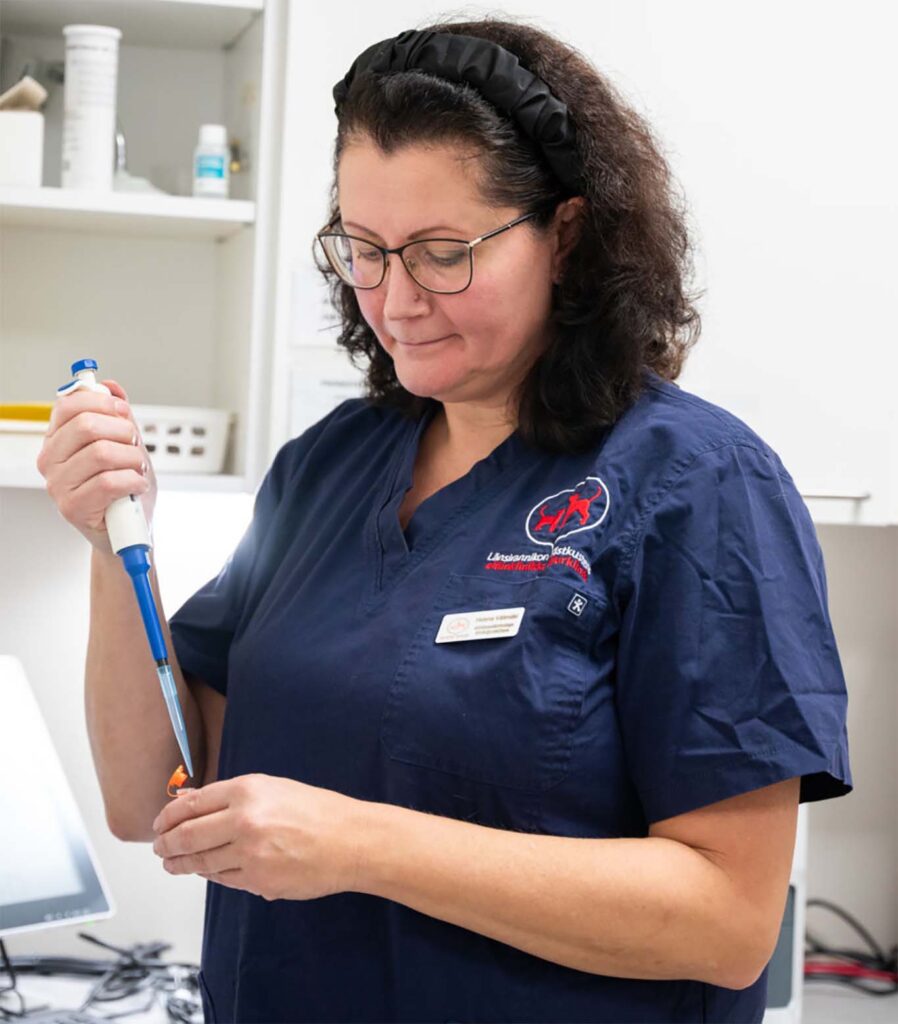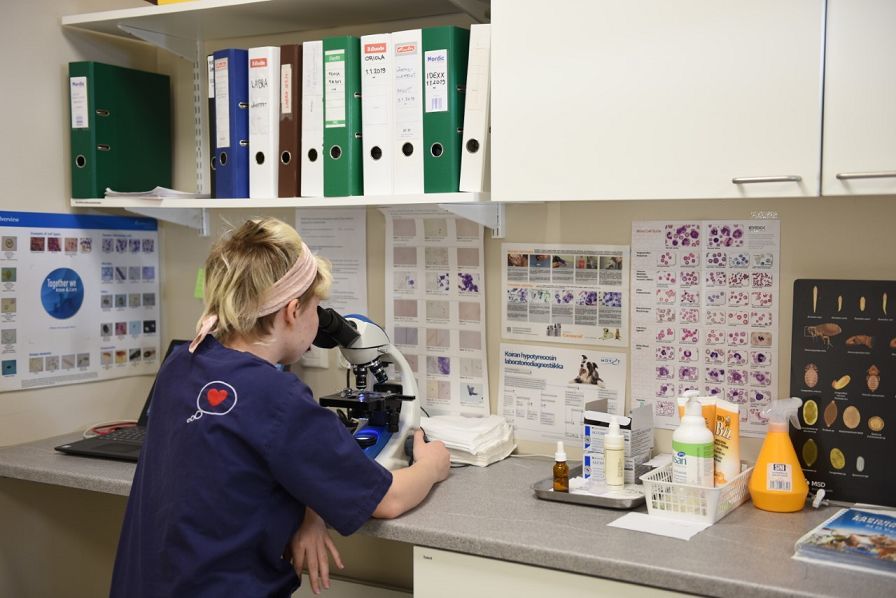Laboratory
Our laboratory is open from Monday to Friday between 8:00–15:00.
Pick up a sample container for a urine or stool sample, which have been ordered by our vets, from our clinic beforehand!
Blood samples
Blood tests are a part of our daily routines. With cats and dogs, blood samples are usually taken from the cephalic vein at the front edge of the forelimb. We may have to sedate a restless animal for this procure, but most of our patients allow us to take the sample without too much fuss.
As a rule, the animal must not eat anything for about 12 hours before the blood test to ensure a reliable result (this applies to many types of serum samples).
Blood samples allow us to investigate a number of things. Blood samples are used in the examination of diseases of the internal organs, the evaluation of hormone levels, the monitoring of inflammation, allergy examinations, etc.

We can examine a wide range of blood samples ourselves at the clinic
We use a ProCyte haematology analyser (e.g. red and white blood cell counts, white blood cell differential), a Catalyst chemistry analyser (e.g. internal organ profile, progesterone, C-reactive protein, blood sugar) and a Quickvet analyser of blood coagulation and blood type. They provide us with the results in about half an hour.
Some samples we send to IDEXX Vet Med Lab in Germany using a courier service (the results usually arrive the next day and the laboratory in question also operates during weekends, which means we receive the results for Friday’s samples on Monday). For some tests, we also use the IDEXX Vetlab laboratory in Tampere and the Movet laboratory in Kuopio.
Urine samples
A urine sample can be taken at the clinic using the cystocentesis procedure (a needle through the abdominal wall), by catheterising, or at home as a “free flow” sample into a clean container as the pet urinates. Sampling by cystosentesis is always the best method.
At some cases the vet may approve a free flow sample (for instance follow up´s).
Before taking a sample at home, we recommend washing the fur and the area around your pet’s genitalia with shampoo and rinsing well with water to ensure as clean a sample as possible. You can use a freezer container with a lid or some other clean receptacle as a sample container. One handy way to collect a sample is to wrap a freezer bag around a sauna ladle so that the sample goes straight into the bag. We only need about 1 tablespoonful of urine for a sample.
A cat’s urine sample is often easiest and most practical to do at the clinic, but there is also urine sample collection sand available at the clinic if you prefer to take the sample at home.
A sample can be analysed if it is no older than 4–5 hours. This is due to the changes that occur in urine when stored. If you can’t bring the sample to the clinic immediately, we recommend storing it in the refrigerator.

DNA samples
DNA samples usually involve a buccal or cheek swap or a hair or blood sample.
DNA tests are most commonly performed for parentage verification. They can be done when you want to make sure that the puppies or kittens are registered with the right parents, for example, in ambiguous cases, when double mating has occurred or simply on the breeder’s request.
These days there are DNA tests available for both cats and dogs that chart numerous disease-causing genes. They are usually voluntary. Such tests are performed on the breeder’s request, on the recommendation of a breed association or based on a breed charting campaign. Because there are numerous tests and laboratories that perform them available, it is the pet owner’s responsibility to acquire the necessary referrals and information from the laboratory of their choice before we take a DNA sample.
A research group from the University of Helsinki and Folkhälsan Research Center (led by Hannes Lohi) has established a gene bank for collecting genetic material for the benefit of current and future research projects. It is particularly important to collect samples from a dog that is suffering from a hereditary disease and its close relatives. You can request for such a sample to be taken during a visit to a vet – but please make sure to mention it when making the appointment. The storing of the sample is free, but the veterinary clinic will charge you for the cost of taking the sample, and postage and packing.
The samples can be used to analyse an instant strip test, DNA precipitation and bacteria culture. Some examinations of internal diseases also require the analysis of a urine sample.
Biopsies & cytology
Biopsies and cell samples are extremely common.
When examining an inflammation of the ear it is necessary to analyse the cells of the discharge from the ear to find out what kind of an inflammation it is. The ear discharge will reveal bacteria, yeast infections, white blood cells, etc. which are helpful in determining the right medication. Of course, it may be necessary to also carry out other analyses alongside a biopsy (such as bacteria cultures, etc.) Any discharge is also analysed during follow-up.
If your pet has a rash, we can also analyse the skin tissue for additional information about what may be causing it.
We can take fine-needle aspiration samples from tumours, etc. or take s surgical/punch biopsy.
Additionally, we can analyse the cells of synovial fluid, any fluid in the abdominal cavity, etc. as needed.
Stool samples
The analysis of a stool sample is often required when investigating the reasons behind longer-lasting digestive disorders (diarrhoea). A stool sample can be used to analyse, for example, various parasites and the composition of intestinal flora. The sample will also allow us to determine the medication susceptibility of the pathogenic bacteria which will help us select a targeted drug.
Often one stool sample from one faeces will be enough for our needs (we need about 1 tablespoonful). In some cases, we may recommend collecting stools on three consecutive days: for example, when investigating parasites.
In case you just want the stool sample to be analyzed for the possible need for deworming, you can order sample materials and the service directly from the laboratory.
https://kauppa.vita.fi/news/14/tutki-kissan-tai-koiran-madotustarve-ennen-kuin-laakitset
Microbiology
Microbiological analyses are extremely common because many diseases are either directly caused by microbes, or they are complications following a disease caused by microbes. The most common diseases requiring microbiological analysis are urinary tract infections, inflammation of the ear, rashes, and wounds and abscesses that are not healing as they should.
At our clinic, we can perform bacteria cultures and drug-susceptibility tests on common pathogenic bacteria. The duration of a bacteria culture and drug-susceptibility test is usually between 3 to 5 working days. Often the medication has to be started immediately, but it can be adapted later to make it more effective if the results of the analysis reveal that this is necessary. Sometimes the pathogen turns out to be mycosis (a contagious disease caused by a microscopic fungus), but this can usually be determined already during the biopsy analysis.


